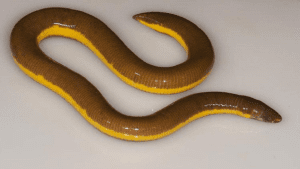TAG: GS 3: ECOLOGY AND ENVIRONMENT
THE CONTEXT: In a remarkable scientific breakthrough, a new species of striped caecilian has been discovered in Kaziranga National Park, Assam.
EXPLANATION:
- This finding emerged from a departmental survey of amphibians and reptiles conducted between June 14 and June 17.
- This discovery is notable not only for adding to the biodiversity of the region but also for highlighting the ecological significance of Kaziranga National Park.
Striped caecilian
- The newly discovered striped caecilian belongs to the Ichthyophis genus.
- Caecilians are limbless, serpentine amphibians that primarily live underground or in aquatic environments, making them elusive and challenging to study.
- The discovery was made during a survey aimed at documenting amphibian and reptile species in Kaziranga as the monsoon season began, a period marked by increased activity among amphibians.
- The identification of the striped caecilian is significant for several reasons:
- Biodiversity: It adds a new species to the already rich biodiversity of Kaziranga National Park.
- Ecological Understanding: It enhances the understanding of the ecological complexity and species diversity in the park.
- Conservation Efforts: The discovery underscores the importance of ongoing conservation efforts and the need to protect diverse habitats.

Striped Caecilian
Kaziranga National Park
- Kaziranga National Park is a national park in the Golaghat and Nagaon districts of the state of Assam, India.
- The park, which hosts two-thirds of the world’s Indian rhinoceroses, is a UNESCO World Heritage Site.
- According to the census held in March 2018 which was jointly conducted by the Forest Department of the Government of Assam and some recognized wildlife NGOs, the rhino population in Kaziranga National Park is 2,613.
- Kaziranga National Park, encompassing 1,307 square kilometers, is characterized by a diverse mix of floodplains, wetlands, grasslands, and hilly terrains.
- This variety of habitats supports a wide range of wildlife, including numerous amphibian and reptile species.
- The park’s unique ecological composition provides an ideal environment for species like the caecilian to thrive.
Training and Conservation
- As part of the survey, training sessions were conducted to enhance the skills and knowledge of forest staff in identifying and conserving amphibians.
- These sessions are crucial for improving the management and protection of these species, ensuring that forest staff are well-equipped to monitor and conserve the park’s diverse wildlife.
Historical Context
- Kaziranga National Park has a history of significant wildlife discoveries.
- In the previous year, the park recorded the presence of several species for the first time, including the long-tailed Nigni, Binturong, and small-clawed otters.
- These findings, along with the recent discovery of the striped caecilian, emphasize Kaziranga’s role as a vital sanctuary for wildlife.

